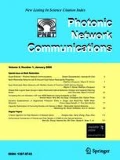Abstract
In Optical Burst Switching (OBS), packets travel through the network core as part of longer-size optical bursts, which do not suffer electronic conversion until they reach an eggress point. Typically, such optical bursts comprise tens or hundreds of packets, which are assembled/deassembled at border nodes. During the burst-formation process, each arriving packet must wait until the final burst is complete, which clearly adds an extra delay on each packet in the burst, especially on those arriving earlier. However, such burst-assembly delay may be excessive for the appropriate performance of certain applications, mainly real-time interactive ones. This work’s findings are twofold: first, it characterises the burst-assembly delay distribution of each packet in a burst arisen by the main assembly algorithms found in the literature; and, second, it introduces a new burst-assembly strategy that takes into account the particular delay constrains of packets in the formation of optical bursts, along with a detailed study of its properties.
Similar content being viewed by others
References
Cao, X. et al. (2002). Assembling TCP/IP packets in Optical Burst Switched networks. In: Proceedings of IEEE GLOBECOM, Taipei, Taiwan, vol. 3 (pp. 2808– 2812)
Choi, J.Y. et al. (2004). The effect of burst assembly on performance of Optical Burst Switched networks. Lecture notes in Computer Science, vol. 3090 (pp. 729–739)
Choi J.Y., Choi J.S., Kang M. (2005). Dimensioning burst assembly process in Optical Burst Switching networks. IEICE Transactions of Communications E88-B(10): 3855–3863
David H.A. (1981). Order statistics. New York, John Wiley & Sons, Inc
de Vega Rodrigo, M., & Gotz, J.: (2004). An analytical study of Optical Burst Switching aggregation strategies. In: Proceedings of Broadnets, (Workshop on OBS), San Jose, California
Detti A., Eramo V., Listanti M. (2002). Performance evaluation of a new technique for IP support in a WDM optical network: Optical Composite Burst Switching (OCBS). IEEE/OSA Journal of Lightwave Technology 20(2):154–165
Dolzer, K., & Gauger, C. (2001) On burst assembly in Optical Burst Switching networks—a performance evaluation of Just-Enough-Time. In: Proceedings of the 17th International Telegraffic Congress (pp. 149–160)
Ge A., Callegati F., Tamil L.S. (2000). On optical burst switching and self-similar traffic. IEEE Communication Letters 4(3): 98–100
Haga, P. et al. (2006). Understanding packet pair separation beyond the fluid model: the key role of traffic. In: Proceedings of IEEE INFOCOM Barcelona, Spain
Iizuka, M. et al. (2002). A scheduling algorithm minimizing voids generated by arriving bursts in Optical Burst Switched WDM networks. In: Proceedings of IEEE GLOBECOM, Taipei, Taiwan, vol. 3 (pp. 2736–2740)
Izal, M., & Aracil, J. (2002). On the influence of self-similarity on optical burst switching traffic. In: Proceedings of IEEE GLOBECOM, Taipei, Taiwan, vol. 3 (pp. 2308–2312)
Karagiannis, T. et al. (2004). A nonstationary Poisson view of Internet traffic. In: Proceedings of IEEE INFOCOM, Hong Kong, PRC, vol. 3 (pp. 1558–1569)
Klinkowski, M. et al. (2005). Impact of burst length differentiation on QoS performance in OBS networks. In: Proceedings of ICTON, Barcelona, Spain, vol, 1 (pp. 91–94)
Leavens, K. (2002). Traffic characteristics inside optical burst switching networks. In: Proceedings of SPIE/IEEE OPTICOMM, Boston, Massachusetts
Liu, J., & Ansari, N. (2004). The impact of the burst assembly interval on the OBS ingress traffic characteristics and system performance. In: Proceedings of IEEE ICC, Paris, France, vol. 3 (pp. 1559–1563)
Qiao C., Yoo M. (1999). Optical burst switching (OBS)—A new paradigm for an optical Internet. Journal of High-Speed Networks 8(1): 69–84
Vokkarane, V.M. et al. (2002). Generalized burst assembly and scheduling techniques for QoS support in Optical Burst-Switched networks. In: Proceedings of IEEE GLOBECOM, Taipei, Taiwan, vol. 3 (pp. 2747–2751)
Vokkarane, V., Haridoss, K., & Jue, J.P. (2002). Threshold-based burst assembly policies for QoS support in optical burst-switched networks. In: Proceedings of SPIE/IEEE OPTICOMM, Boston, Massachusetts (pp. 125–136).
Xiong M., Vandenhoute Y., Cankaya H.C. (2000) Control architecture in optical burst switched WDM network. IEEE JSAC 18(10): 1838–1851
Xu L., Perros H.G., Rouskas G. (2001). Techniques for optical packet switching and optical burst switching. IEEE Communication Magazine 39(1): 136–142
Yu, X., Chen, Y., & Qiao, C. (2002). Study of traffic statistics of assembled burst traffic in optical burst switched networks. In: Proceedings of SPIE/IEEE OPTICOMM, Boston, Massachusetts (pp. 149–159)
Yu, X., Chen, Y., & Qiao, C. (2002). Performance evaluation of Optical Burst Switching with assembled burst traffic input. In: Proceedings of IEEE GLOGECOM, Taipei, Taiwan,vol. 3 (pp. 730–731)
Yu, X. et al. (2003). Performance evaluation of TCP implementations in OBS networks, Tech. Rep. 2003-13, CSE Department, SUNY Buffalo, NY
Yu X. et al. (2004). Traffic statistics and performance evaluation in Optical Burst Switching networks. IEEE/OSA Journal of Lightwave Technology 22(12): 2722–2738
Zapata, A., & Bayvel, P.: Impact of burst aggregation schemes on delay in Optical Burst Switched networks. In: Proc. IEEE/LEOS Annual Meeting, Tucson, Arizona (pp. 57–58)
Zhang, Q. et al. (2005). Analysis of TCP over Optical Burst-Switched Networks with burst retransmission. In: Proceedings of IEEE GLOBECOM, vol. 4 St. Louis, MO
Author information
Authors and Affiliations
Corresponding author
Additional information
This work has been funded by the “Ministerio de Educación y Ciencia” of Spain under grant TEC2006-03246.
Rights and permissions
About this article
Cite this article
Hernández, J.A., Aracil, J., López, V. et al. On the analysis of burst-assembly delay in OBS networks and applications in delay-based service differentiation. Photon Netw Commun 14, 49–62 (2007). https://doi.org/10.1007/s11107-006-0048-8
Received:
Revised:
Accepted:
Published:
Issue Date:
DOI: https://doi.org/10.1007/s11107-006-0048-8




